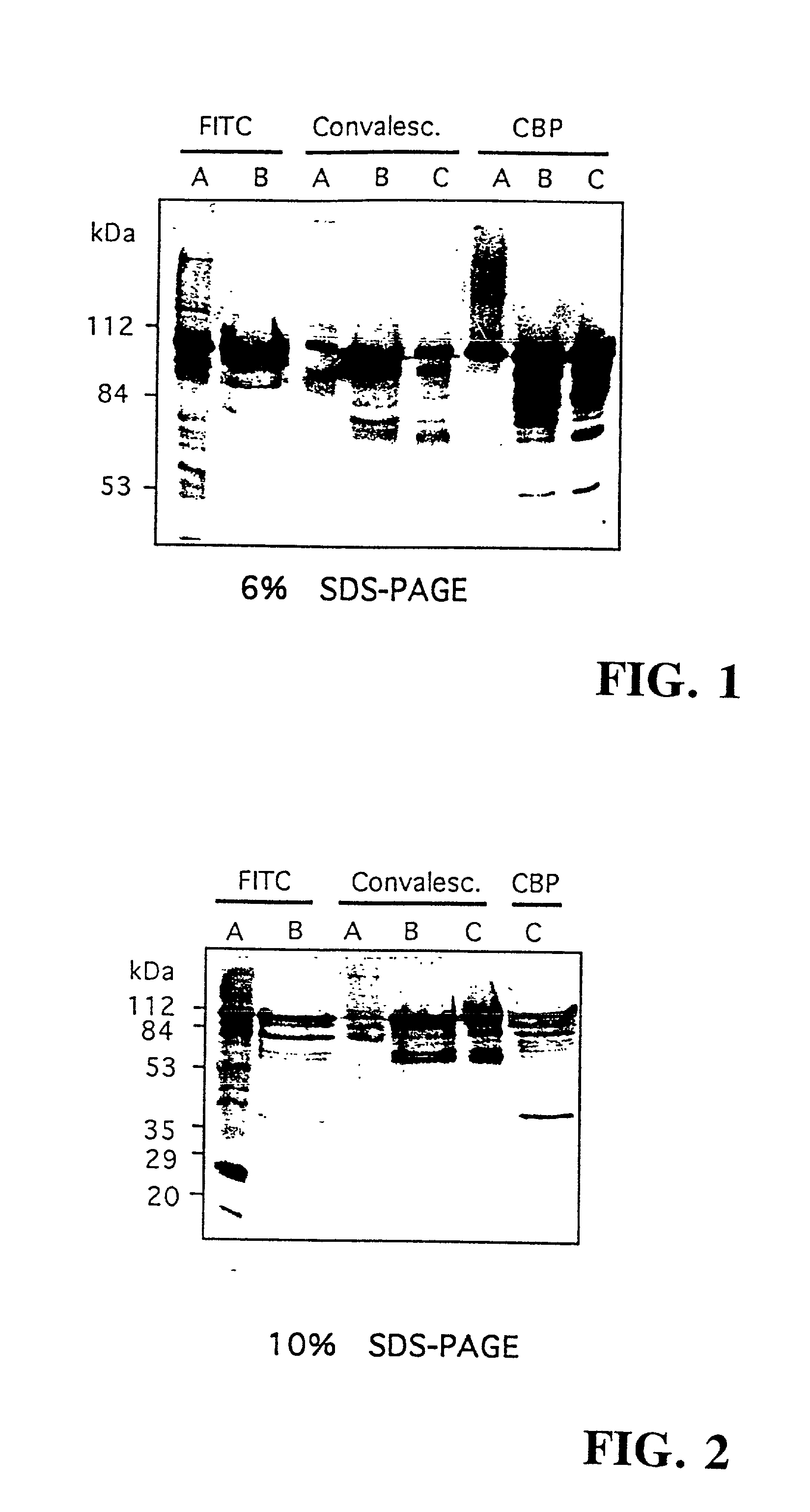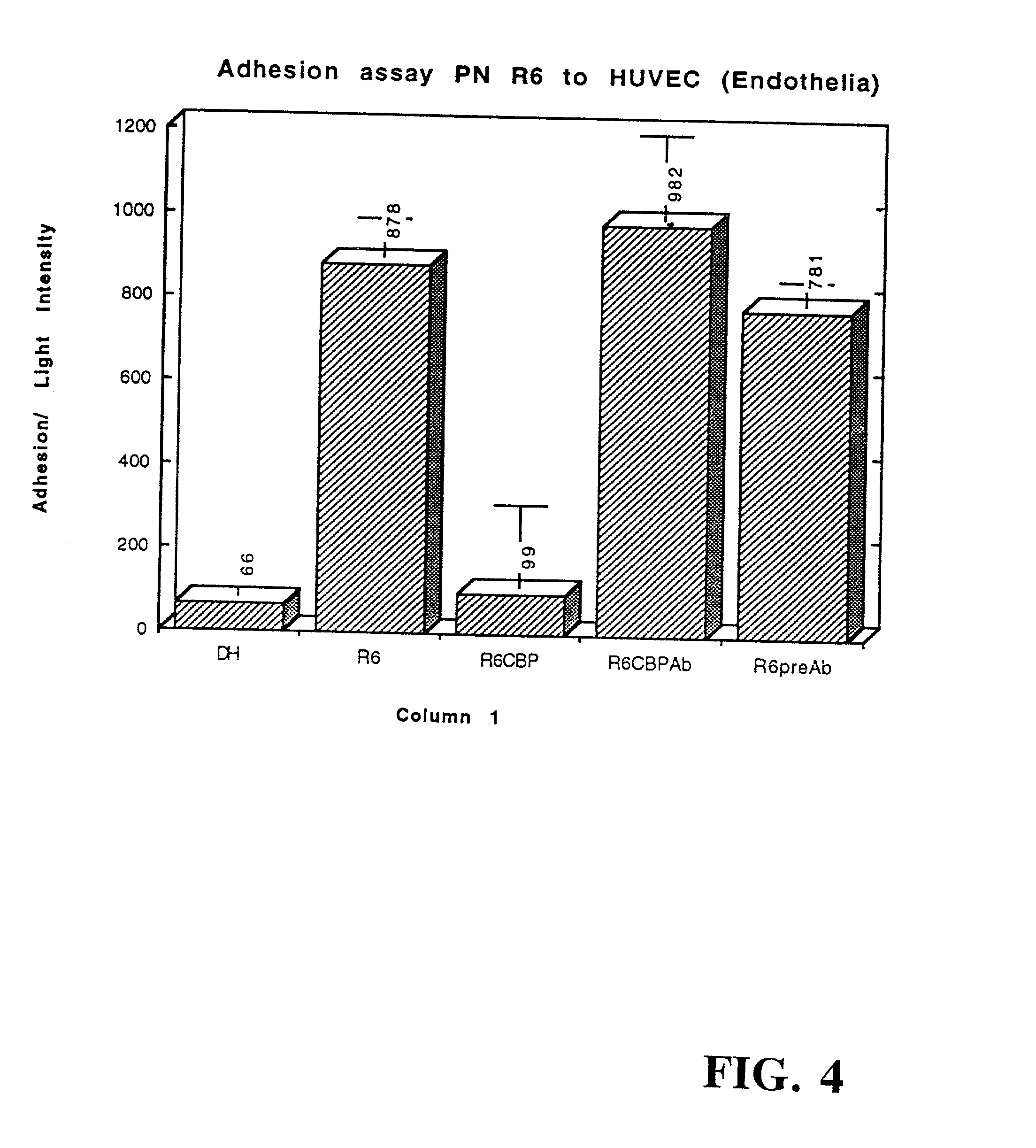Choline binding proteins for anti-pneumococcal vaccines
a vaccine and choline technology, applied in the field of choline binding proteins for anti-pneumococcal vaccines, can solve the problems of difficult diagnosis of infection with gram positive bacteria, failure to elicit humoral or cellular immune response, etc., to increase the potential effectiveness of vaccines, prevent death, and modulate bacterial adherence
- Summary
- Abstract
- Description
- Claims
- Application Information
AI Technical Summary
Benefits of technology
Problems solved by technology
Method used
Image
Examples
example 1
Identification of Pneumococcal Choline Binding Proteins
Materials and Methods
[0259] Strains. Bacterial strains used included (1) R6, an unencapsulated bacterial strain derived from D39 (type 2), unencapsulated, (2) AII encapsulated, (3) LM91 derived from D39 (encapsulated), which is PspA.sup.-, and (4) Lyt.sup.- derived from D39, unencapsulated.
[0260] Cell culture and choline binding protein purification. Cultures of 0.1 ml bacteria LM91 (-80.degree. C. stock) were cultivated in 10 ml C+Y semisynthetic medium for 5 hours at 37.degree. C. This 10 ml culture was then used to inoculate 400 ml C+Y, and this culture was incubated for 5 hours at 37.degree. C. in 5% CO.sub.2 to an OD.sub.620 of 0.6. To this mixture was added 4 ml choline agarose beads (CAB), and this was incubated 30 minutes at 37.degree. C. in 5% CO.sub.2, with occasional shaking. The bacteria and beads were centrifuged at 4.degree. C. for 15 minutes at 8000.times.g, and the pellet was resuspended in 50 ml rest medium (C+Y...
example 2
Characterization of Pneumococcal Choline Binding Proteins
[0265] The CBPs isolated by SDS-PAGE were subjected to N-terminal amino acid sequence analysis. The protein fraction obtained from a choline agarose column eluted from 0.5 M choline chloride was applied to an SDS polyacrylamide gel transferred to a PVDF membrane, and stained for protein. Individual bands were excised and N-terminal amino acid sequence obtained by Edman degradation. Internal sequence data was obtained from protease generated peptide fragments. Amino acid sequence data for 8 of the 9 CBPs were obtained as follows:
5 CBP112 XENEGSTQAATSSNMAKTEHRKAAKQVVDE (SEQ ID NO:1) CBP90 AREFSLEKTR (SEQ ID NO:2) CBP84 XREFSLEKTRNIGIMAHVDAGKT (SEQ ID NO:3) CBP80 XKXXWQXKQYLKEDGSQAANEXVFDTA (SEQ ID NO:4) CBP78 QKIIGIDLGTTNSAVAVLEGTESKIIANPE (SEQ ID NO:5) CBP70 XXXEVAKXSQDTTTAS (SEQ ID NO:6) CBP60 XNERVKIVATLGPAVEGRG (SEQ ID NO:7) CBP50 XIIXXVYAREVLDSRGNP (SEQ ID NO:8) CBP112-Int1 EDRRNYHPTNTYK (SEQ ID NO:9) CBP112-Int2 XDDQQAEEDY...
example 3
Pneumococcal Choline Binding Proteins Block Adherence
[0267] The CBP fraction isolated in Example 1 was used in an adherence assays to determine its effect on pneumococcal adherence to type II lung cells (LC) and endothelial cells of the vasculature (EC) as described in International Patent No. PCT / US95 / 07209, filed Jun. 6, 1995 by Tuomanen and Cundell, which is specifically incorporated herein by reference in its entirety. The CBP fraction blocked pneumococcal adherence by 45% to LC and 89% to EC in a dose-dependent manner (FIGS. 3 and 4, respectively).
PUM
| Property | Measurement | Unit |
|---|---|---|
| apparent molecular weight | aaaaa | aaaaa |
| apparent molecular weight | aaaaa | aaaaa |
| apparent molecular weight | aaaaa | aaaaa |
Abstract
Description
Claims
Application Information
 Login to View More
Login to View More - R&D
- Intellectual Property
- Life Sciences
- Materials
- Tech Scout
- Unparalleled Data Quality
- Higher Quality Content
- 60% Fewer Hallucinations
Browse by: Latest US Patents, China's latest patents, Technical Efficacy Thesaurus, Application Domain, Technology Topic, Popular Technical Reports.
© 2025 PatSnap. All rights reserved.Legal|Privacy policy|Modern Slavery Act Transparency Statement|Sitemap|About US| Contact US: help@patsnap.com



